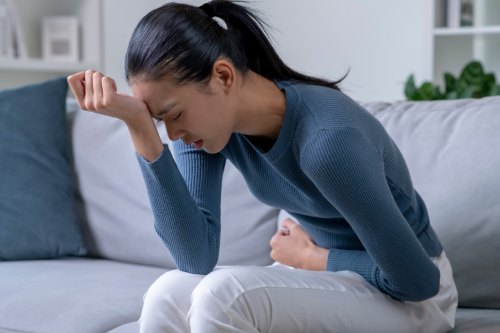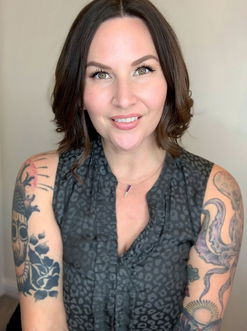Premenstrual Dysphoric Disorder and TCM

Premenstrual syndrome (PMS) is a very common part of many people’s menstrual cycles, but what does it mean when PMS is so severe that it's negatively impacting someone's life? Premenstrual dysphoric disorder (PMDD) is a severe form of PMS, which affects a small percentage of people who menstruate and is characterized by extreme mood shifts that are significant enough to interfere with and impact daily life and relationships. PMS and PMDD share most symptoms, but there are some differentiating qualities of presentation that help us to distinguish PMDD from PMS. Symptoms for both PMS and PMDD occur in the luteal phase of the menstrual cycle, a week or two before menstruation. Common symptoms of PMDD include severe depression, feelings of hopelessness, intense anger or irritability, feelings of tension or anxiety, mood swings, difficulty concentrating, brain fog, fatigue, changes in appetite, insomnia or excessive sleepiness, and physical symptoms like breast tenderness, bloating, joint and muscle pain.
To distinguish between PMS and PMDD, we need to look at the severity of specific symptoms, the duration, and, of course, if there has been a medical diagnosis in the past. While PMS symptoms are typically bothersome, they don't impact the person's quality of life in the same way that PMDD does, and it is important to reiterate that although PMDD and PMS share many characteristics, the PMDD presentation is significantly more severe and usually inclusive of abrupt mood changes with feelings of hopelessness, anxiety and depression. Additionally, even though symptoms of PMS and PMDD both occur during the luteal phase, PMDD symptoms can extend beyond this phase; beginning at ovulation and lasting through menstruation. One of the primary subjective signs of PMS is that the patient usually experiences some relief of symptoms once menstruation has started or is completed.
Common Western treatments for PMDD include SSRI medications, hormonal birth control, and cognitive behavioral therapy to deal with stress. Still, many patients find these treatments unacceptable or intolerable, and they may not even truly get to the crux of alleviating symptoms.
In my practice, I see many patients who suffer from PMS and PMDD. For some the symptoms are transient and manageable, but for others, the symptoms can seem to take over a patient’s life, leaving them with only ten or so ‘good days’ a month. During perimenopause, which can begin as early as age 35, the symptoms of PMDD are usually exacerbated so to help these patients find relief, we need to have a basic understanding about the role of hormone fluctuations and γ-aminobutyric acid (GABA).
The Role of Progesterone & GABA
After reaching their peak levels during a woman's cycle, during the luteal phase, both estrogen and progesterone levels decline prior to the onset of menses. Specifically, in terms of mood changes, it’s understood that it is the fluctuation of these hormone levels, rather than the actual levels themselves, that can be primary factors in the onset of these and other symptoms. Simply put, we are most sensitive to the abrupt change in hormone levels, and the level itself is less relevant. PMDD is linked to unstable progesterone concentrations, so this fluctuation of progesterone is a major factor in PMDD as well as in the methodology of treatment.
Many people are given combination hormonal birth control as a treatment for PMDD, which can be helpful because it stops the cycling of hormone fluctuations. However, “progesterone-only” medications are not indicated as they may worsen mood changes, because they are made with synthetic progestin, which are accompanied with other adverse effects. In contrast, the neuroactive metabolite of progesterone, allopregnanolone (ALLO), is correlated with favorable effects (Stefaniak, M. et al. 2023). This is due to allopregnanolone’s interaction with γ-aminobutyric acid type A receptors, GABA-A. GABA induces significant anti-depressant, anti-stress, sedative, and anxiolytic effects. PMDD, postpartum depression, and the mood changes that occur in perimenopause can all be related to insufficient neuroactive steroid action from low progesterone derivative concentration, unstable hormone levels, and decreased receptor sensitivity. Many menstruating people find encouraging results by supplementing with natural progesterone in the luteal phase of the menstrual cycle. ALLO is only available as an IV drug because it does not survive the action of the first pass effect of the liver when taken orally. To add progesterone orally, micronized progesterone or transdermal progesterone cream may be used. One can imagine that these forms have the same effect on γ-aminobutyric acid. If a patient is taking estrogen-only birth control pills, then supplementing with oral, natural progesterone could be advantageous.
GABA is an inhibitory amino acid and neurotransmitter. Low levels of GABA are associated with most mental illnesses, and correct levels of GABA help us to feel calm and relaxed and reduce sensations of overwhelm and anxiety. Benzodiazepine medications like xanax and valium work on GABA receptors to increase GABA reception, thus causing a sensation of relaxation and anti-anxiety effect. When mood is part of the patient’s picture, we should always consider the influence of GABA.
For relief of symptoms, modulating GABA is particularly helpful, and there are three ways that we can address this. The first is to increase the amount of GABA in the system, second is to decrease the breakdown of GABA in the system, and lastly is to increase the amount of GABA receptors. Pharmaceutical medications are the only way to increase GABA receptor sensitivity and decrease the breakdown of GABA in the body, but we do have several natural options to increase the amount of GABA. These natural remedies include green, white or oolong tea, yoga or vigorous exercise, meditation and breathing for 20 minutes each day, as well as foods such as beans, nuts, seeds, fish, fruits and vegetables, and cocoa. Additionally, over the counter GABA supplements can also be helpful, and of course there are Chinese herbal formulas that can help to modulate GABA. One of my personal favorite formulas for patients with PMS, PMDD as well as patients with mood disorders and anxiety, is Yue Jue Wan.
An Ode to Yue Ju Wan
Yue Ju Wan, also known as Escape Restraint Pill, is a classic formula that I didn’t pay much attention to until finding a study that showed Yue Ju Wan to have superior effects over fluoxetine for depression in a clinical trial (Zhou et al., 2022). That news made me turn my head and give it another look. Yue Ju Wan is an elegant formula containing only five herbs, one for each type of stagnation: Qi, Food, Damp, Blood, and Heat. When we think about this formula with a more abstract lens, I think it becomes obvious how it might help with the symptoms of depression and anxiety from a TCM point of view. Yue Ju Wan also acts on GABA-A neurotransmission, meaning not only does it have anti-depressant effects, but it also has calming, anti-anxiety effects (Xue et al 2013). One of the active principles in the decocted formula is ligustilide, a component that affects GABA-A neurotransmission (Wei et al., 2008).
Every type of stagnation can be correlated to different mood disorders and symptoms. Naturally, it seems that the treatment method of moving these stagnations would likely benefit the patient’s mood, mental health, and any underlying symptomology. The specific indications for the formula are Qi stagnation in the Middle Jiao and Liver Qi invading the Stomach. Liver Qi invading the Stomach, or Wood overacting on Earth, is a TCM pattern I often see in patients with mood disorders, particularly those whose symptoms manifest somatically with digestive upset, pain, or indigestion. What I love about Yue Ju Wan is that it usually has markedly immediate effects; the patients can use this formula as needed, usually from ovulation through the 1st to 3rd day of the next menstrual cycle. A common complaint with cyclical anti-depressant use is the negative side effects of discontinuing the medication; which can include an uptick in anxiety, depression, mood swings, and odd physical sensations like tingling and ‘brain zaps.’ With Yue Ju Wan, we rarely see these types of systemic effects upon discontinuation, which makes it easy for patients to have good adherence to the protocol.
Our classic Xiao Yao San / Wan is, of course, another herbal formula option with anti-depressant effects, also showing to be as effective, and sometimes even more effective, than traditional pharmaceuticals (Gubili, n.d.). Xiao Yao San / Wan is also a go-to of mine for patients with PMS and PMDD, particularly when there is an element of significant stress or overwork involved. My preference is for Jia Wei Xiao Yao San, but of course, it would be very patient-dependent according to their TCM pattern and constitution. Studies also show prevalent anti-depressive and anxiolytic effects from Jia Wei Xiao Yao San (Xie et al 2023). So, the question remains – how do you choose?
Similar Yet Different
These formulas are classically similar, yet quite different. Both affect the Middle Jiao, move Qi and Blood, and have excellent anti-depressant and anxiolytic effects. The slight difference is that Jia Wei Xiao Yao San / Wan has some slight tonification properties, whereas Yue Ju Wan is almost solely about movement of stagnation.
The patient I picture for Yue Ju Wan is stuck, stagnated, and has emotional symptoms that could stem from any issue, but they might have a difficult time properly addressing and processing those emotions. Essentially, they are so stuck that it feels impossible to move what needs to move, or even to assimilate the depth of what they are experiencing. This is similar to a patient that may benefit from Jia Wei Xiao Yao San, who also presents with stagnation, but with a hallmark of emotional defeat and perhaps some more overt somatic symptoms such as GI disturbance. The Jia Wei Siao Yao San / Wan patient is stuck and can’t get things to move, not only because of the sheer weight of the stagnation but also because they lack the reserves and energy to move it.
In a sense, these formulas could easily be interchangeable, and each patient might prefer one over the other even if diagnostically, it doesn’t quite line up. I would encourage you to experiment with both to determine which formula works best for them.
REFERENCES:
- Gubili, Y. N. H. J. (n.d.). Use of traditional Chinese medicine herbal formula Xiao Yao San to relieve depression and anxiety. The ASCO Post. https://ascopost.com/issues/april-10-2022/use-of-traditional-chinese-medicine-herbal-formula-xiao-yao-san-to-relieve-depression-and-anxiety/
- Shorter, E., & Segesser, K. (2013). Traditional Chinese medicine and Western psychopharmacology: building bridges. Phytotherapy research : PTR, 27(12), 1739–1744. https://doi.org/10.1002/ptr.4940
- Stefaniak, M., Dmoch-Gajzlerska, E., Jankowska, K., Rogowski, A., Kajdy, A., & Maksym, R. B. (2023). Progesterone and Its Metabolites Play a Beneficial Role in Affect Regulation in the Female Brain. Pharmaceuticals (Basel, Switzerland), 16(4), 520. https://doi.org/10.3390/ph16040520
- Wei, X. H., Cheng, X. M., Shen, J. S., & Wang, Z. T. (2008). Antidepressant effect of Yueju-Wan ethanol extract and its fractions in mice models of despair. Journal of ethnopharmacology, 117(2), 339–344. https://doi.org/10.1016/j.jep.2008.02.004
- Xie, J., Xu, D., Wang, C., & Huang, J. (2023). Jiawei Xiaoyao San in treatment of anxiety disorder and anxiety: A review. Chinese herbal medicines, 15(2), 214–221. https://doi.org/10.1016/j.chmed.2022.12.007
- Xue, W., Zhou, X., Yi, N., Jiang, L., Tao, W., Wu, R., Wang, D., Jiang, J., Ge, X., Wang, Y., Wu, H., & Chen, G. (2013). Yueju pill rapidly induces antidepressant-like effects and acutely enhances BDNF expression in mouse brain. Evidence-based complementary and alternative medicine : eCAM, 2013, 184367. https://doi.org/10.1155/2013/184367
- Zou, Z., Huang, J., Yang, Q., Zhang, Y., Xu, B., Wang, P., & Chen, G. (2022). Repeated Yueju, But Not Fluoxetine, Induced Sustained Antidepressant Activity in a Mouse Model of Chronic Learned Helplessness: Involvement of CaMKII Signaling in the Hippocampus. Evidence-based complementary and alternative medicine : eCAM, 2022, 1442578. https://doi.org/10.1155/2022/1442578


